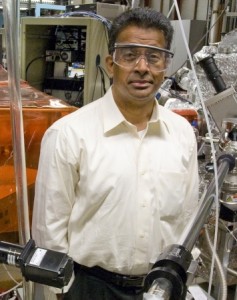 |
| This AFM image shows a recoverable phase transformation in a bismuth ferrite film introduced by an applied electric field. The dashed blue line shows the relocation of the phase boundaries. |
Listen up nickel-titanium and all you other shape-memory alloys, there’s a new kid on the block that just claimed the championship for elasticity and is primed to take over the shape memory apps market at the nanoscale.
A research team at Berkeley Lab has discovered a way to introduce a recoverable strain into bismuth ferrite of up to 14-percent on the nanoscale, larger than any shape-memory effect observed in a metal. This discovery opens the door to applications in a wide range of fields, including medical, energy and electronics.
“Our bismuth ferrite not only displayed the champion shape-memory value, it was also far more stable when reduced to nanometer size than shape-memory alloys,” says Jinxing Zhang, a post-doc for this study under Ramamoorthy Ramesh of Berkeley Lab’s Materials Sciences Division and now a faculty member at Beijing Normal University. “Also because our bismuth ferrite can be activated with only an electrical field rather the thermal fields needed to activate shape-memory alloys, the response time is much faster.”
The shape-memory effect is the metallic equivalent of elasticity, in which a solid material “remembers” and recovers its original shape after being deformed by an applied stress. In the past, this has always involved heating. Shape-memory alloys have had a big impact in the medical field with the most prominent being nickel-titanium or “nitinol,” which is used in stents for angioplasty, and in mechanical joints. The shape-memory effect is also expected to have a major impact in non-medical applications, such as actuators in smart materials and in Microelectro-Mechanical Systems (MEMS). However, as the size of current shape-memory alloys shrink towards the nano-scale, numerous problems and instabilities arise, including fatigue, micro-cracking and oxidation.
“By achieving the shape-memory effect in an oxide material rather than a metal alloy, we eliminate the surface issues and enable integration with microelectronics,” says Zhang. “Our bismuth ferrite also displays an ultra-high work function density during actuation that is almost two orders of magnitude higher than what a metal alloy can generate.”
Bismuth ferrite is multiferroic compound comprised of bismuth, iron and oxygen that has been studied extensively in recent years by Ramesh and his research group. As a multiferroic, bismuth ferrite displays both ferroelectric and ferromagnetic properties, meaning it will respond to the application of external electric or magnetic fields. In this latest study, in addition to the conventional thermal activation, an elastic-like phase transition was introduced into bismuth ferrite using only an electric field.
“The application of the electric field allowed us to achieve a phase transformation that was reversible without the assistance of external recovery stress,” Ramesh says.
“Although aspects such as hysteresis, micro-cracking and so on have to be taken into consideration for real devices, the large shape-memory effect we demonstrated in bismuth ferrite shows it to be an extraordinary material with potential use in future nanoelectromechanical devices and other state-of-art nanosystems.”
The bismuth ferrite shape-memory effect was characterized at the National Center for Electron Microscopy (NCEM), a U.S. Department of Energy national user facility housed at Berkeley Lab. Results of this research were published in the journal Nature Communications. The paper was titled “A nanoscale shape-memory oxide.” In addition to Zhang and Ramesh, other co-authors were Xiaoxing Ke, Gaoyang Gou, Jan Seidel, Bin Xiang, Pu Yu, Wen-I Liang, Andrew Minor, Ying-hao Chu, Gustaaf Van Tendeloo and Xiaobing Ren.


No comments:
Post a Comment